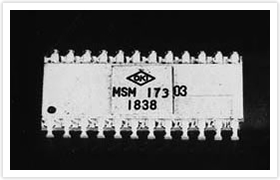Part 13: Successful Development of a CMOS IC—Becoming a Leading Manufacturer of IC for Watches
Semiconductor technology continued to advance, and ICs (Integrated Circuits), each embedded with multiple circuit elements, were commercialized in the 1960s. OKI began researching ICs in 1965, focusing its efforts on creating innovations in the field of MOS-ICs, and opened up a new market by developing the CMOS IC for use in watches and in cameras.
Development of an IC for electronic switching systems
In 1959, Jack Kilby of the United States created an IC in which multiple components were contained within a single semiconductor crystal. The invention of this new type of IC had an enormous impact around the globe, as it turned a silicon crystal with the function of a single transistor into a circuit instead of just an electrical component. The IC was most notable for its small size, light weight, and low power consumption as compared to a transistor. It allowed electronic calculators, which once occupied nearly half an office desk, to be shrunk down to handheld devices.

Early ICs
OKI was convinced that a shift was underway from transistors to ICs. In December 1965, OKI established an IC Research Section, and assigned it the task of developing, by 1971, an IC approved by NTT (then Nippon Telegraph and Telephone Public Corporation) for use in its electronic switching systems. The R&D team was thus given a time limit of six years. Transistors can be classified roughly into two types: bipolar transistors and field-effect transistors. Although theoretical research at the time was more advanced in the area of field-effect transistors, bipolar transistors were commercialized first. OKI's R&D team concentrated on the development of bipolar-type ICs.
Despite a number of twists and turns along the way, OKI successfully developed a bipolar-type IC for electronic switching systems in December 1971, on schedule, and the IC was officially approved by NTT. This bipolar-type IC was used in the D10 electronic switching system delivered to NTT as well as in various terminal devices, and was a key milestone in OKI's incorporation of electronics into its products.
Shifting from field-effect transistors to ICs
After filling in-company demand for those ICs, they were then sold to meet the needs of outside customers. Meanwhile, OKI continued its own development activities. The company was tackling the challenge of developing ICs that would replace MOS (Metal Oxide Semiconductor) field-effect transistors. Development was held back by difficulties related to silicon processing. When silicon processing technology was successfully industrialized around 1965, it allowed for the near-immediate development and commercialization of MOS ICs.
OKI started its research in 1965, when MOS ICs were first introduced. In the early years, MOS ICs had slower operating speeds than bipolar-type ICs, leading some within the company to call for a halt in development. The R&D team, however, recognized that MOS ICs have certain advantages. For example, MOS ICs can be manufactured using simple manufacturing processes, and the circuit density can be increased fairly easily. Because of these advantages, the R&D team insisted on continuing research based on the conviction that MOS ICs would offer sufficient performance for 80% to 90% of electronic products despite the slow operating speed.
The year 1966 was a turning point. That year, OKI held a demonstration to show off a watch incorporating an MOS IC, and the demonstration was seen by a member of the Gifu Prefectural Police Department. OKI was asked to develop a speed detector to help with enforcement of the speed limit. The product developed by OKI was acclaimed, drawing a lot of attention, especially in Gifu, and OKI officially commenced the production of MOS ICs in April of 1967.
First to mass produce ICs for LCD digital watches
As a result of active research into improving the stability of insulating film using a silicon nitride membrane, OKI's R&D team was able to successfully develop an innovative type of MOS IC. The R&D team realized a high-performance circuit on a single chip by using N-type and P-type MOS transistors. Because this IC was a complementary MOS IC, it was called a "CMOS." Utilizing proprietary technology, OKI was able to ensure continuous operation for more than one year using only a 1.5-V battery.

Custom-designed ICs for use in watches
The development of the CMOS IC began with a request from a watchmaker. In those years, watchmakers used transistors to produce electronic watches. The watches cost about 1,000,000 yen each and therefore, understandably, did not sell well. One watchmaker asked OKI to develop a new IC that would allow them to reduce the cost of their products, but insisted on a highly challenging specification requirement: the IC had to operate on just 1.5 V. Unfortunately, OKI was not able to meet the needs of this customer; the technologies available to OKI and other semiconductor manufacturers at the time were insufficient. However, recognizing the need for such ICs, the R&D team continued their development activities with this target in mind, and was later able to successfully create a CMOS that operated on just 1.5 V.
Then, in 1972, at the request of Casio Computer Co., Ltd, OKI developed the world's first ICs for digital watches with liquid crystal displays (LCD). Overseas IC manufacturers soon followed suit, but OKI established itself as a leading manufacturer of ICs for watches by mass-producing unique multifunction products.
Creating unique, never-before-seen technologies... OKI's commitment to developing ICs stemmed from its pioneering spirit, which underlies the very foundations of OKI. During that period, Japan's high economic growth began to slow, and then came to an end with the oil crisis of the 1970s. It is also worth noting that OKI's management had the foresight to recognize that ICs had the potential to stand as a new and important pillar of its business, and used them as a catalyst to further vitalize business activities.